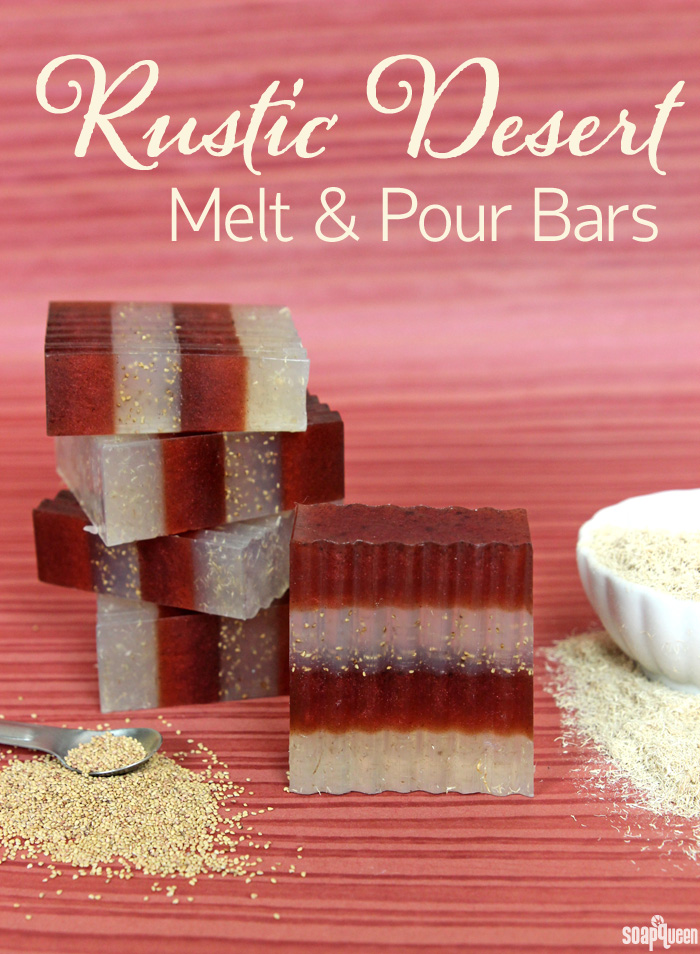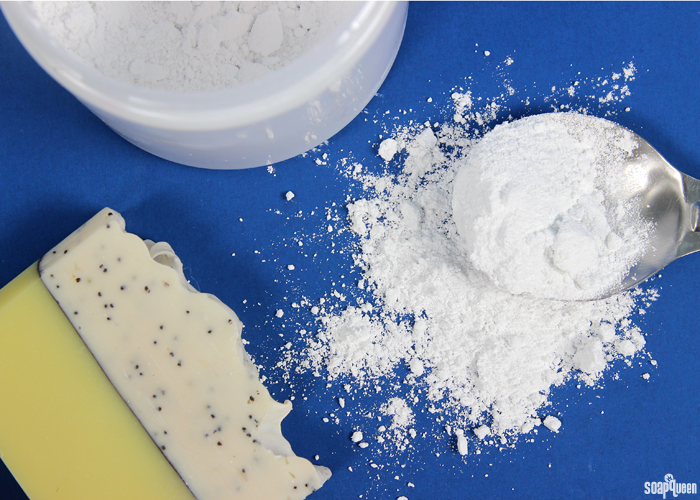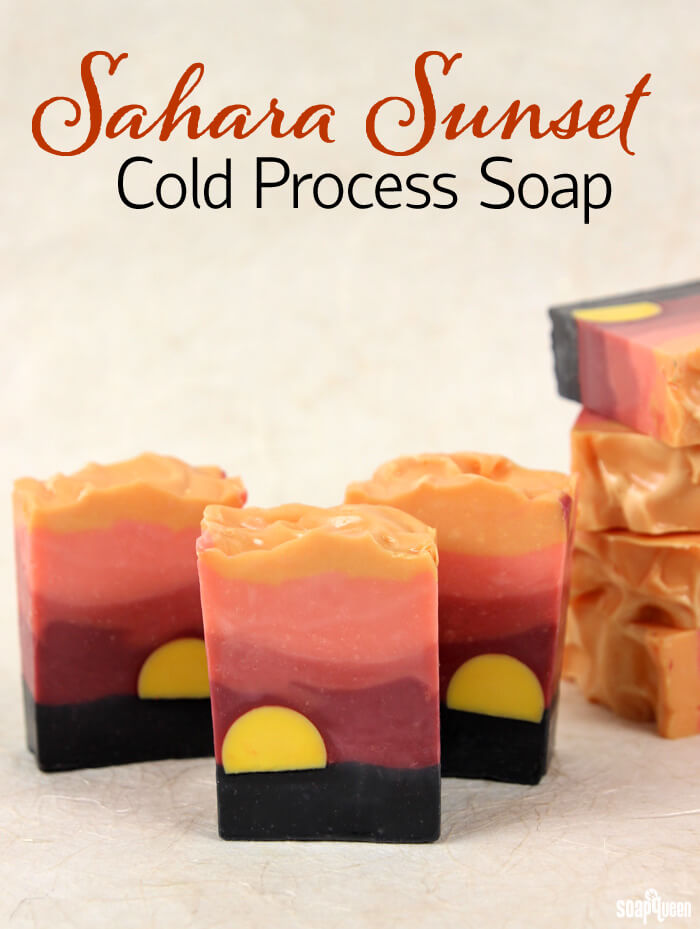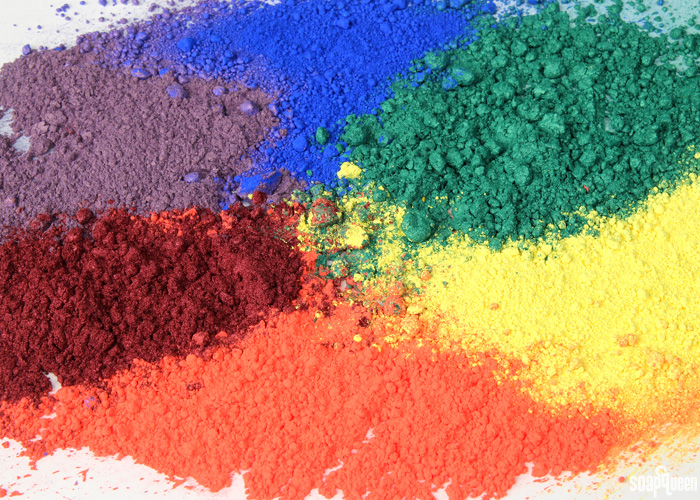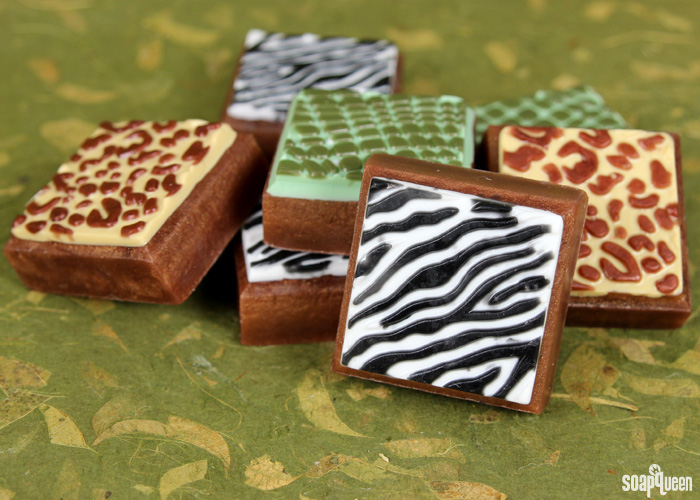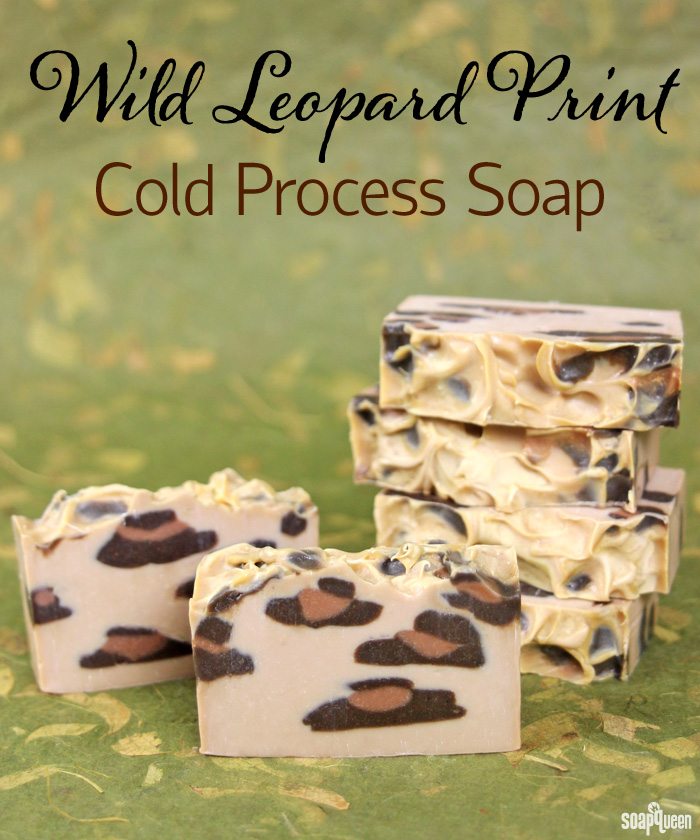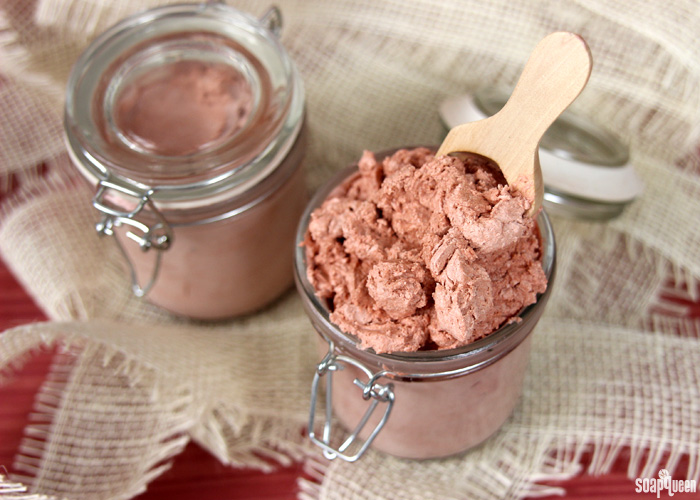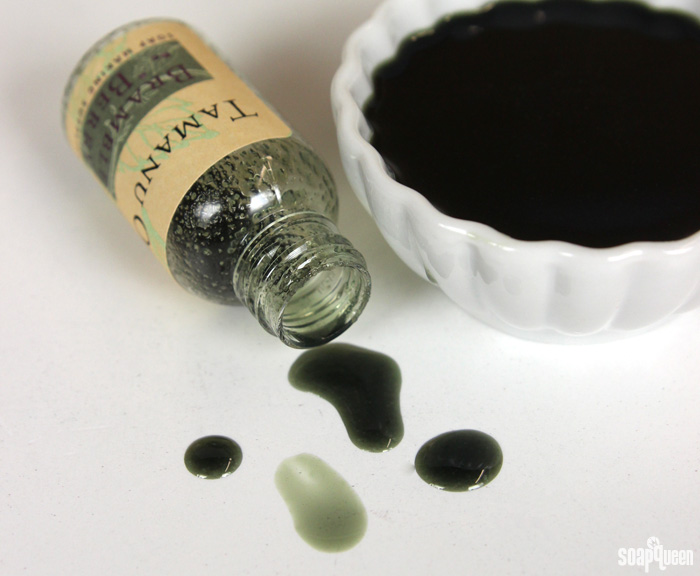I love making soap with vibrant color, sparkle and embeds. For instance, the Honey Bee Funnel Pour Cold Process Soap or the Rainbow Hearts Melt & Pour. However, it’s nice to switch it up every now and then and make a rustic, simple-looking soap. These Rustic Desert Melt and Pour Bars are striking, simple and have exfoliants in them to help with rough summer skin.
Soaping in the Summer Heat
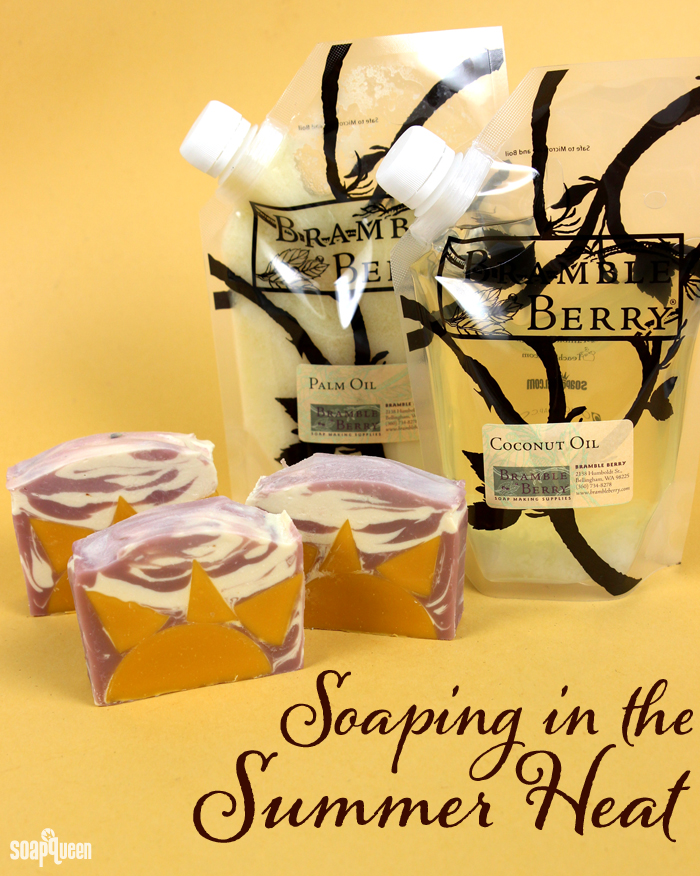
Now that summer has officially begun, temperatures are on the rise and in some area of the country, are way way up (Shout out and cooling thoughts to Arizona, Arkansas and Eastern Washington). If you are a summer person like me and live in a more moderate climate, this is great news! I absolutely love spending time in the warm weather and outdoors hiking, biking and swimming. However, the heat does affect how certain soapy ingredients need to be handled. Butters, oils and other ingredients change consistency when exposed to higher temperatures. This is especially true when ingredients and products are being shipped and sit in a hot delivery truck for long periods of time.
If you have ordered from Bramble Berry recently, you may have received liquid oils or butters when you were expecting a firm texture. All solid oils and butters have a melting point where they melt from a solid into a liquid. Once the butters cool down again, they will resolidify. The quality of butters and oils does not decrease by melting and solidifying several times. But remember to always fully melt your entire container of palm oil to ensure your soap receives the proper ratio of all the fatty acids.
Average Melting Point of Common Hard Soapmaking Oils and Butters
Avocado Butter about 90° F
Cocoa Butter about 100° F
Coffee Butter about 104° F
Mango Butter about 86° F
Shea Butter about 90° F
Coconut Oil 76° F
Palm Kernel Flakes about 102° F
Palm Oil 95-97° F
Beeswax 144-147° F
Sunday Night Spotlight: Titanium Dioxide
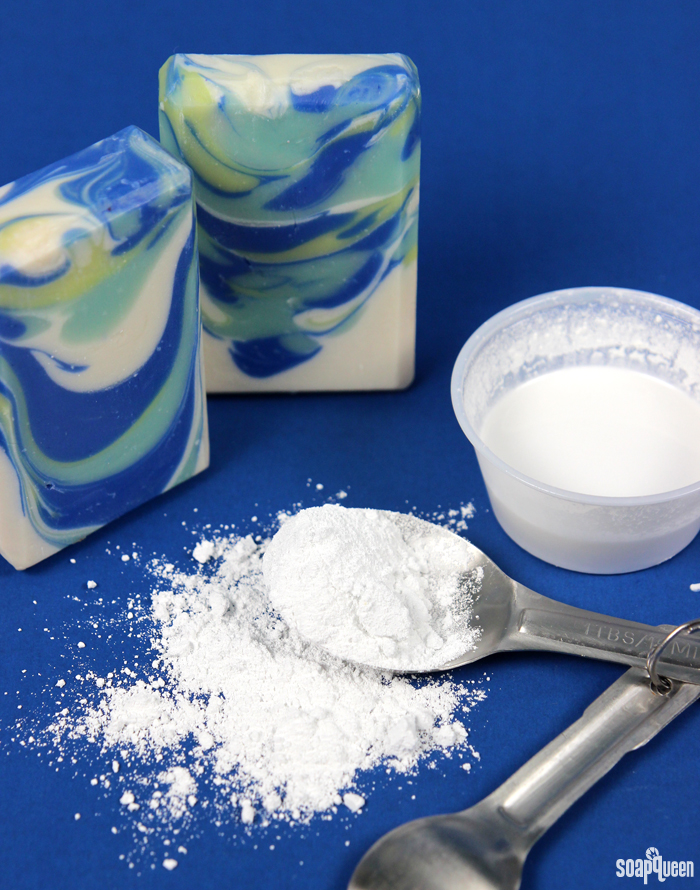
Pigments and oxides are one of the most popular colorant options for cold process soap. They are non-bleeding and don’t morph in the high pH environment of freshly poured soap. Oxides come in a wide variety of hues, and are easy to mix to create unique colors. One of the most popular colorants is titanium dioxide, which gives soap a white color. It’s commonly used to transform soap from cream to white, or to lighten other colors.
A natural white opaque pigment, titanium dioxide is used in a wide variety of applications including paints, cosmetic products and food. The mineral is processed to remove impurities, resulting in a pure white color. The titanium dioxide found at Bramble Berry is both oil and water soluble, making it a great option for cold process soap. Titanium dioxide is commonly used in commercial sunscreen products because of its ability to absorb UV light.
Handmade Safari Project Roundup
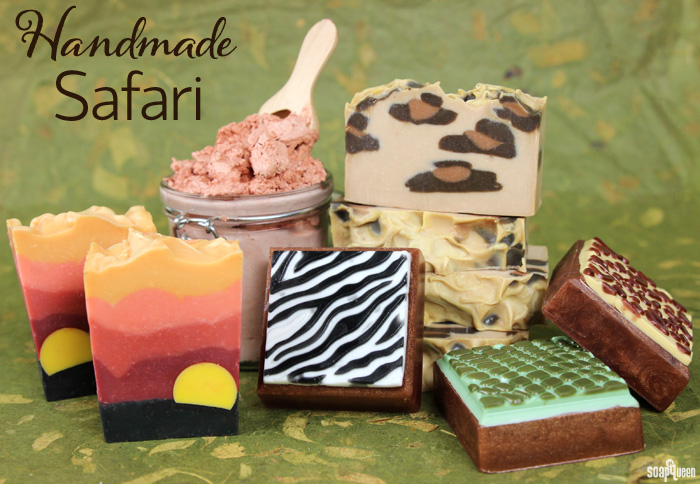
For the past two weeks, the blog has been full of projects inspired by the gorgeous continent of Africa. The first tutorial was the Wild Leopard Print Cold Process Soap, which featured a warm blend of Mayan Gold and Black Tea Fragrance Oils. A small amount ofCinnamon Leaf Essential Oil was added to help give the soap a thicker texture, as well additional spice. To create the realistic leopard print, thick soap is placed into disposable frosting bags and piped in layers (see photo below). If you prefer a brighter color palette, check out the Leopard Spots Tutorial created in 2013.
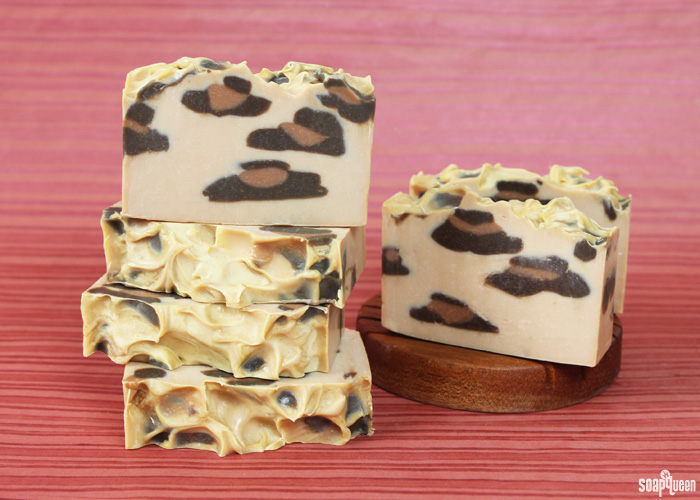
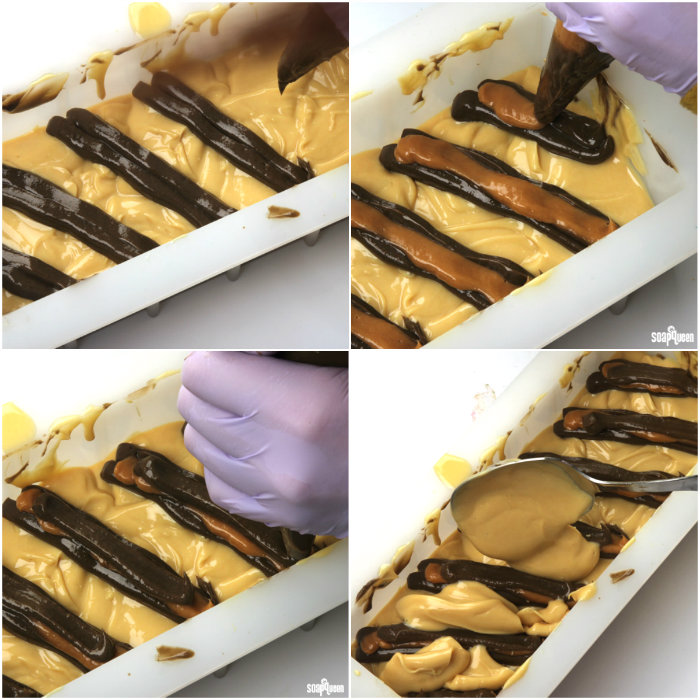
Sahara Sunset Cold Process Soap Tutorial
Soap design inspiration can come from anywhere. From fragrances to color, places and people, inspiration can strike at any moment. This Sahara Sunset Cold Process was inspired by the iconic image of an African sunset. As the bright yellow sun sets over the landscape, the silhouettes of wildlife and flora come to life. The bright yellow sun is created with LCP (like cold process) melt and pour soap. LCP soap has little to no sweating, which makes it perfect for embeds.
Layers of red, orange and yellow cold process are then layered on top. This project is scented with a blend of Patchouli, Orange Peel Cybilla and Beau Brummel Cybilla Fragrance Oils, which results in a citrusy, spicy and complex scent. While this design looks complex, it is actually quite easy to achieve! This design relies on creating layers with medium to thick trace soap. The layers make it a great design choice for accelerating fragrance oils.
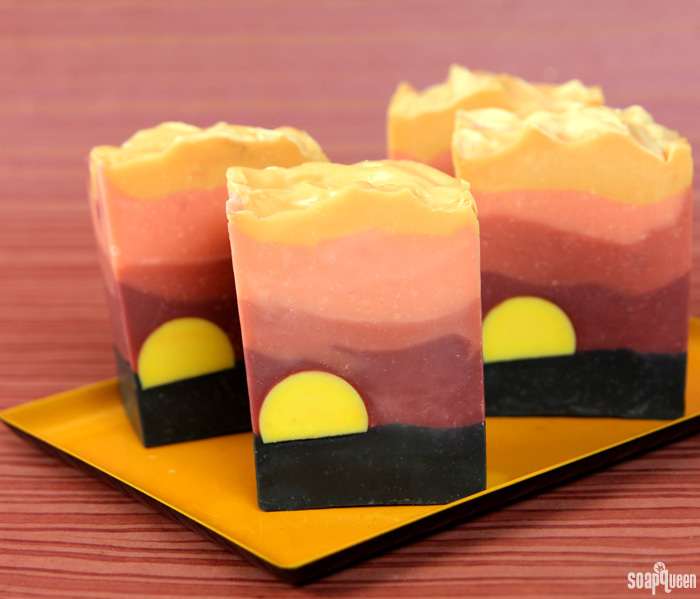
Color Palette Tips + Color Resources
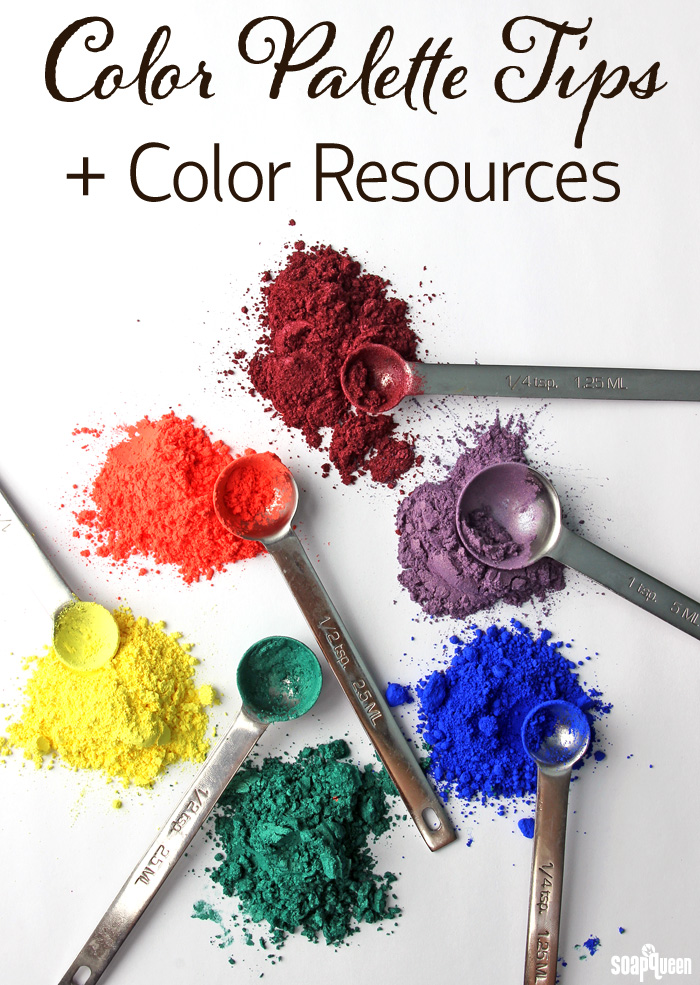
When coming up with a soapy project, my inspiration usually starts with a fragrance oil or color palette. I love pairing various colors together to create different moods and themes with my soap. In general, I tend to gravitate towards really bright and vibrant color palettes, but it’s also fun to play with more subdued and sophisticated color options. Sometimes it can be tricky to choose colors for a soap project, especially because there are so many options! Below are my tips and resources for choosing soapy color palettes.
Before creating color palettes, reintroduce yourself to the color wheel. Remember learning about all the different color rules in elementary school? Well, it’s great to be familiar with them for any kind of art project, including soap!
The basic color groups in the RYB (red, yellow, blue) color wheel include primary, secondary and tertiary colors. Primary colors are red, yellow and blue and are spaced within equal distances from each other on the wheel. Secondary colors are the colors that can be formed by equally mixing primary colors and include orange (red + yellow), green (blue + yellow) and violet (blue + red). Tertiary colors are made from equally mixing one primary color with one secondary color. The names for tertiary colors are usually a combination of the two colors, such as red-orange, red-violet, yellow-orange, etc.
Animal Print Melt and Pour Bars Tutorial
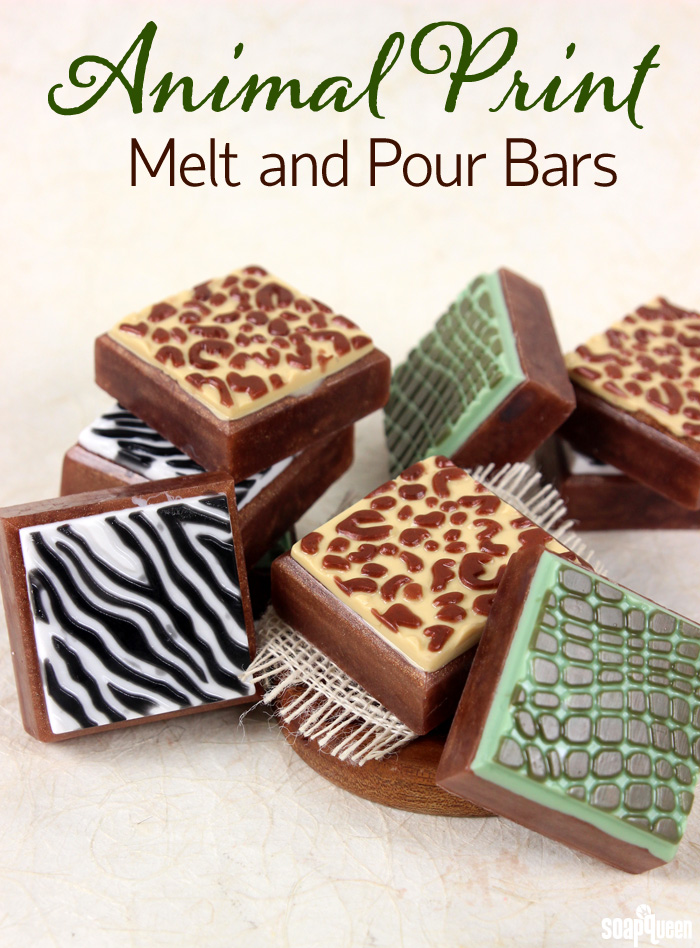 Zebras, alligators and leopards…oh my! This melt and pour project is straight from an African safari. Made with the Animal Print Tray Mold, this project creates nine bars of soap with three different animal prints. Each print is filled in with various colors using a dropper for precise color placement. Scented with Sandalwood Vanilla Fragrance Oil, these bars smell warm, creamy and woodsy.
Zebras, alligators and leopards…oh my! This melt and pour project is straight from an African safari. Made with the Animal Print Tray Mold, this project creates nine bars of soap with three different animal prints. Each print is filled in with various colors using a dropper for precise color placement. Scented with Sandalwood Vanilla Fragrance Oil, these bars smell warm, creamy and woodsy.
For this project, having a spray bottle of 99% isopropyl alcohol is a must. Rubbing alcohol helps layers of melt and pour stick together. The alcohol also helps disperse any bubbles that can occur after pouring. I recommend putting it into a spray bottle to make spraying easy.
Winter and Spring 2015 Fragrance Blends
Fragrance oils are made up of various scents, referred to as top, middle and bottom notes. These notes come together to create a complete and complex fragrance. Designed to smell fantastic alone, fragrance oils can also be blended together to create your own custom blend. Blending fragrance oils together is a lot of fun, but it can sometimes take a little trial and error to get the blends “just right.” If you’d like to learn more about fragrance blending, click here to read my tips and tricks.
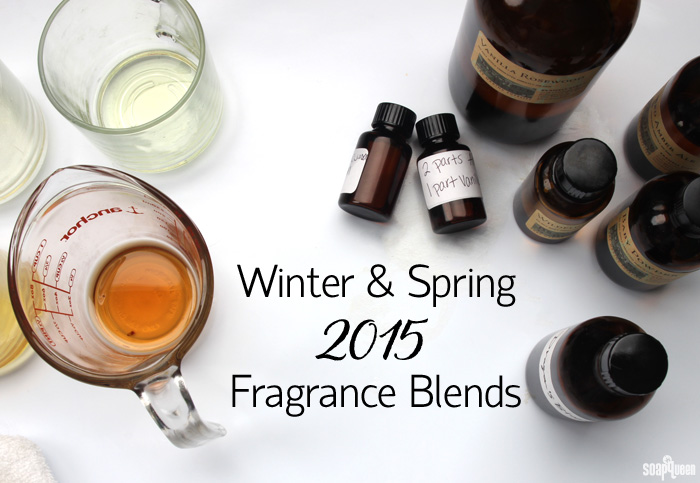
Every month, our team comes up with more than 15 scent blends for each fragrance of the month sample (did you know you get a free .5 oz. fragrance oil sample with each Bramble Berry order?) The team and I chose 4-5 of our favorite blends each month to spotlight. Below are our favorite scent blends for the first six months of 2015. You can always find these blends along with a tutorial on the “Sample of the Month” page, which is located on the right hand side of the Bramble Berry homepage.
[Read more…]
Alabama Soap & Candle Convention
It’s been a full seven years since I last spoke to the Alabama Soap & Candle Association. I don’t want to let another seven years go by before I see them again! The soapers are incredibly warm, passionate and express their love of soaping and makers at every turn. I got more hugs last weekend than I’ve ever gotten in my life – and, it was soul affirming and made my heart happy. I even met a fan who worked at the Delta gate! Hi Jared, it was so nice to meet you!
The speaker line up was incredible – from serious business talks to to product how-to talks. Some of the highlights for me were:
Lela Barker from Lucky Break Consulting. Lela spoke on the importance of branding to help find and protect your niche. Some takeaways from her talk: Branding keeps you stable. You don’t try every new thing. You save money and time by knowing what your customers want and don’t want. Lela said that “each year we are exposed to 25,000 new products and branding cuts through that noise.”
Facebook and Instagram Photo of the Week (June 13th ~ 19th)
With vibrant colors and wild animals, Africa is full of crafting inspiration. This week featured several Africa-inspired projects, including the Whipped Amber Bronzing Butter. The butter gets its fluffy and moisturizing texture from three butters, including coffee butter. It has Copper Sparkle Mica, which adds shimmer and a slight tint to skin. Amber and Ancient Sedona Fragrance Oil are added for a warm scent.
From now until June 27th, receive 25% off a selection of products used in the tutorials. Use coupon code SAFARIMADE at checkout. To see the full collection of Handmade Safari sale items, click here.
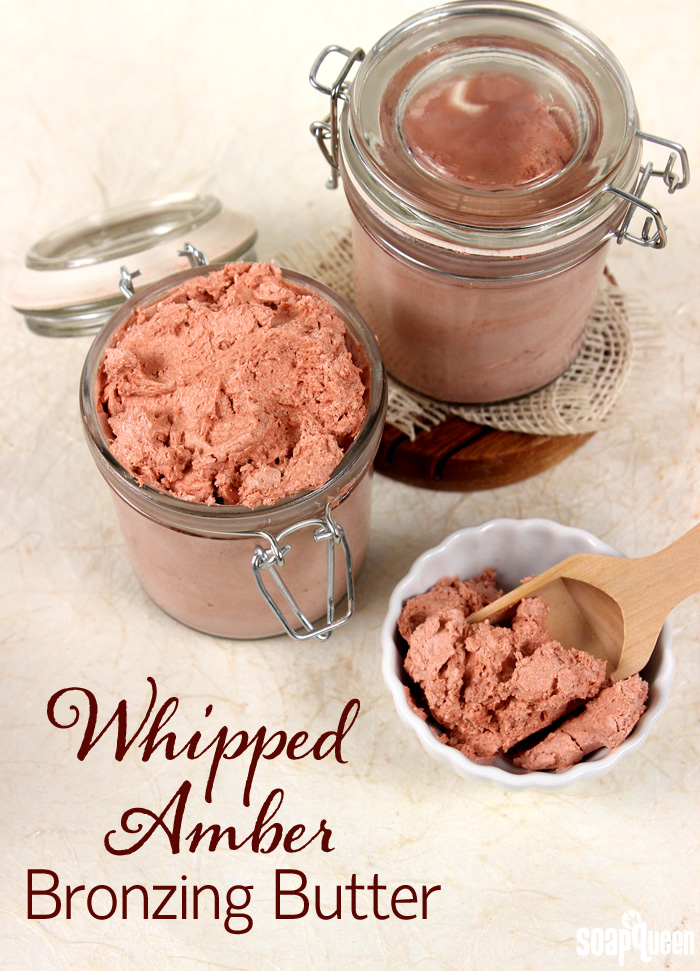
Wild Leopard Print Cold Process Tutorial
This Wild Leopard Print Cold Process soap was inspired by the beautiful coats of African leopards. This artistic soapy effect requires a thick trace to create the spots inside. Soap is placed in frosting bags and layered on top of each other. Once cut, realistic-looking animal spots are revealed! You can see another example of this technique with fun, bright colors in this Leopard Spots tutorial.
This soap is scented with a warm and smoky blend of Mayan Gold and Black Tea Fragrance Oils. A small amount of Cinnamon Leaf Essential Oil adds spice, and helps create a thick trace, as it accelerates. This soap is made with a great blend of oils and butters, including cocoa butter and tamanu oil. The tamanu oil gives this soap batter a bright yellow color, which works great for this color palette. Click here to learn more about tamanu oil.
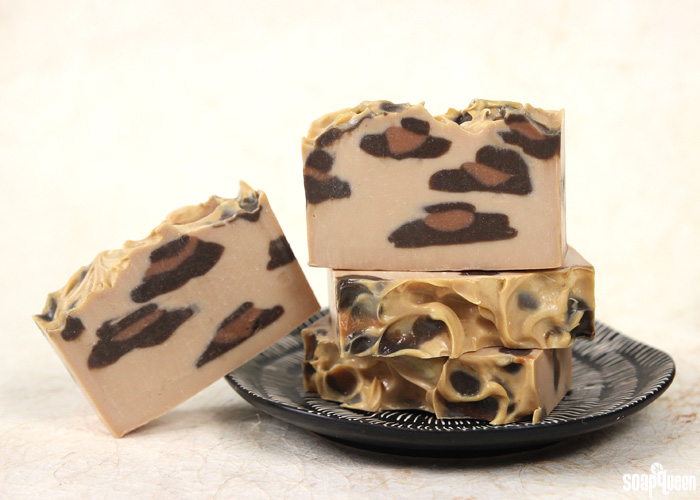
How to Prevent Scent Fading in Soap
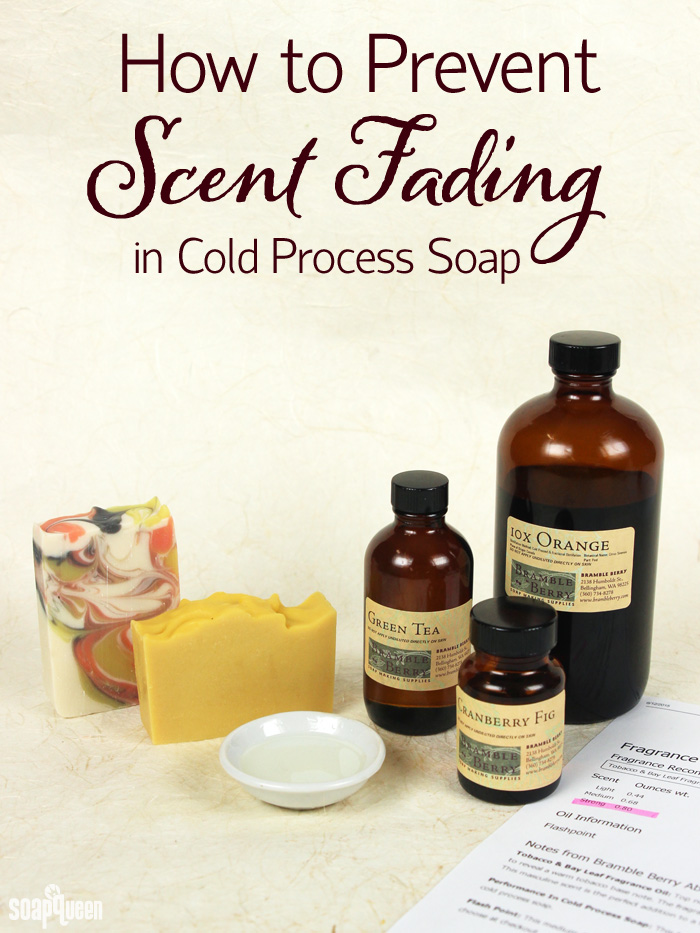
The first time you smell a fragrance or essential oil out of the bottle is definitely memorable. A fragrance can immediately inspire designs, colors and additives for your next soap recipe. But, sometimes the fragrance and essential oils can fade or change in cold process soap. The pH level of cold process soap can attack components of the oil, causing them to smell differently. It can be very disheartening! All Bramble Berry fragrance and essential oils are tested to ensure the scent sticks to cold process soap for months after making the soap. That being said, there are tips and tricks to make scents last even longer.
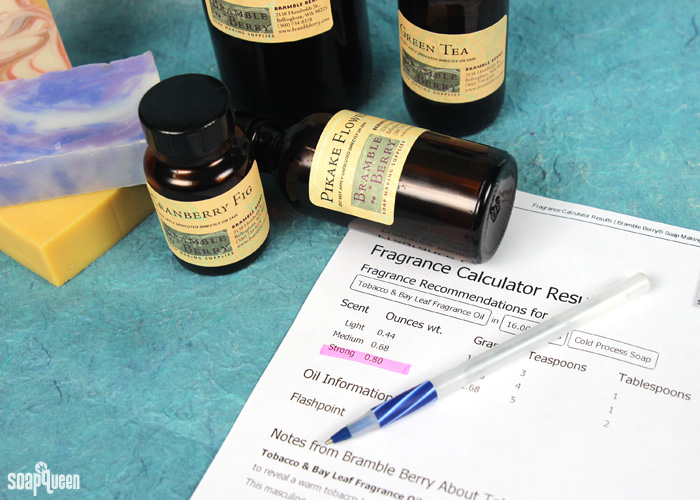
How much fragrance or essential oil used in the recipe plays a big role in scent retention. For a strong scent, with regulations taken into account, you can add .8 ounces of fragrance or essential oil per pound of cold process soap. For melt and pour, you can add .25 ounces of essential oil per pound, or .5 ounces of fragrance oil. This number will vary based on the scent selection. For instance, Almond Fragrance Oil is on the stronger side. Just .16 ounces per pound of cold process soap will provide a hefty scent. To find out exactly how much to add to the recipe, check out Bramble Berry’s Fragrance Calculator. Find out how to use the calculator here.
The Bramble Berry Fragrance Calculator amounts are based on safety guidelines created by IFRA (International Fragrance Association) and RIFM (Research Institute for Fragrance Materials). Each fragrance and essential oil have a maximum usage rate that is deemed safe for bath and beauty products. The “strong,” amount of fragrance recommended by the calculator is based on this maximum usage rate recommended by IFRA and RIFM. Using more than this amount can cause skin irritation.
Whipped Amber Bronzing Body Butter
This Whipped Amber Bronzing Butter is sure to become a summer beauty staple. It’s fluffy, moisturizing *and* sparkly – basically, a trifecta of awesome. First avocado and coffee butters are whipped until smooth. Melted cocoa butter is incorporated, along with a warm and sophisticated scent blend of Amber and Ancient Sedona Fragrance Oil. Once whipped, the butters have a mousse-like texture that spreads easily and absorbs quickly. Tapioca powder is added to help cut the oily feel on the skin.
This whipped body butter contains Copper Sparkle Mica for a slight tint. The amount in the recipe below is great for fair skin, but if you’d like more color feel free to add more! See the bottom of the post for an example of the color. Because it is made of butters, it does have the possibility to melt in high temperatures. I recommend keeping this butter in a cool, dark place and if you ship your products mail order, don’t ship during the summer unless you’re shipping with cool packs. This recipe does not contain any water, which means it does not need a preservative. Click here to learn more about preservatives for bath and beauty products.
Sunday Night Spotlight: Tamanu Oil
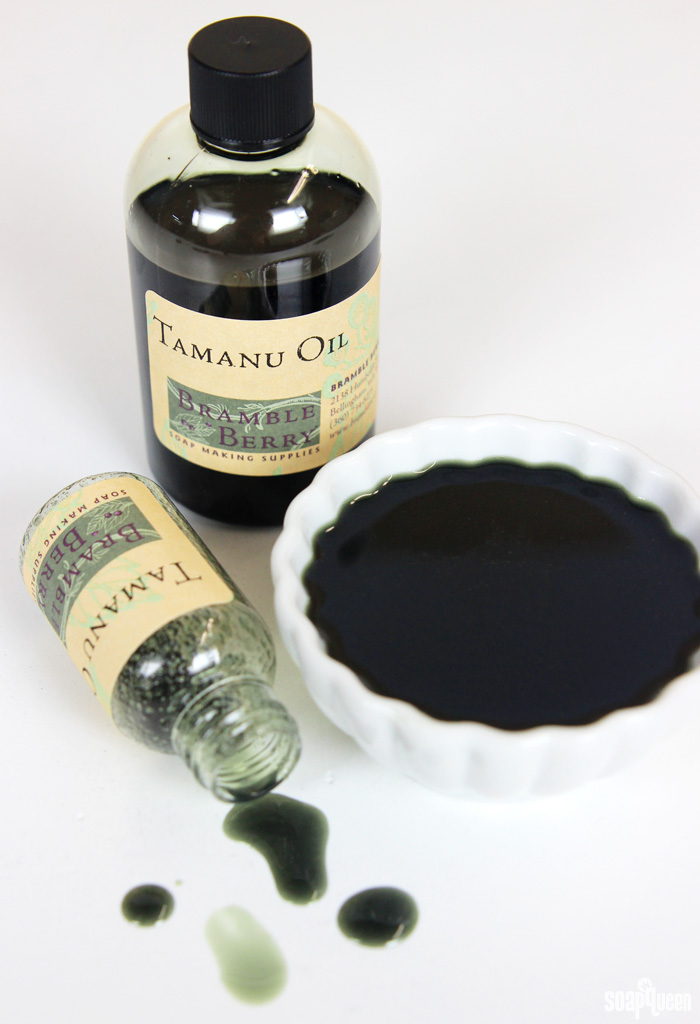
Tamanu oil is pressed from the nuts of the tamanu tree, also known as the “ati-tree.” The tree is indigenous to Southeast Asia and blooms twice a year. The tamanu tree produces sweet-tasting fruit which contains a large nut. Once the kernel is dried in the sun for about a month, it becomes sticky with thick, dark oil. The oil that is pressed from the kernel is tamanu oil. The supply of tamanu oil is very small; it takes about 100 kilograms of tamanu fruit to make roughly 5 kilograms of tamanu oil.
Tamanu oil has a dark green, slightly brown color and a distinctive nutty and earthy aroma. It is widely thought to benefit skin scarring, stretch marks, sores and more. It also has anti-fungal properties. Tamanu oil feels amazing on the skin; it absorbs easily and does not feel greasy. That makes it a great choice for balms, body butters, lotions and more. Tamanu oil is rich in linoleic acid, oleic acid calophyllic acid and lipids. Tamanu oil may separate naturally at cold temperatures. If you notice small specks in your oil, place it in the microwave and heat using short bursts until the specks incorporate.
In cold process soap, we recommend using it at 5% or below. Because of the rich dark color, it may have an effect on the color of your final product, depending on how much you use. In the photos below, the recipe contains 5% tamanu oil. Notice the bright yellow color that the oil makes! The yellow color could be combated by using titanium dioxide, but you may want to avoid cool tones when using tamanu oil in cold process soap. [Read more…]
